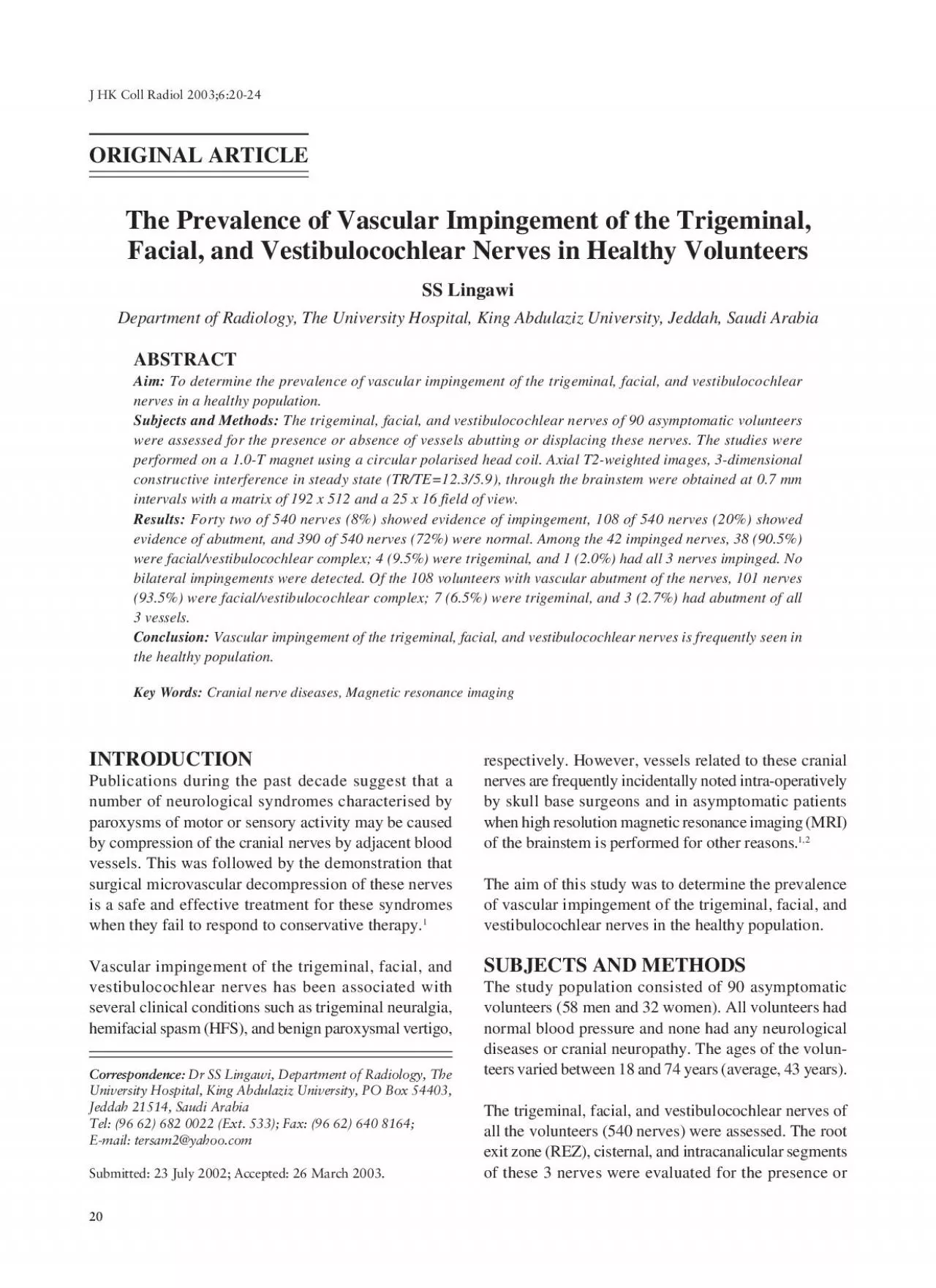

J HK Coll Radiol 200362024 ORIGINAL ARTICLE To determine the prevalence of vascular impingement of the trigeminal facial and vestibulocochlearperformed on a 10T magnet using a circular polarise ID: 941653
Download Pdf The PPT/PDF document "Vascular Impingement of Cranial Nerves20..." is the property of its rightful owner. Permission is granted to download and print the materials on this web site for personal, non-commercial use only, and to display it on your personal computer provided you do not modify the materials and that you retain all copyright notices contained in the materials. By downloading content from our website, you accept the terms of this agreement.
Vascular Impingement of Cranial Nerves20J HK Coll Radiol 2003;6:20-24 J HK Coll Radiol 2003;6:20-24 ORIGINAL ARTICLE To determine the prevalence of vascular impingement of the trigeminal, facial, and vestibulocochlearperformed on a 1.0-T magnet using a circular polarised head coil. Axial T2-weighted images, 3-dimensionalForty two of 540 nerves (8%) showed evidence of impingement, 108 of 540 nerves (20%) showedwere facial/vestibulocochlear complex; 4 (9.5%) were trigeminal, and 1 (2.0%) had all 3 nerves impinged. Nobilateral impingements were detected. Of the 108 volunteers with vascular abu
tment of the nerves, 101 nervesby compression of the cranial nerves by adjacent bloodrespectively. However, vessels related to these cranialnerves are frequently incidentally noted intra-operativelyby skull base surgeons and in asymptomatic patientsteers varied between 18 and 74 years (average, 43 years). SS LingawiJ HK Coll Radiol 2003;6:20-2421 course. However, if a vascular loop was noted to beimpinged nerves, 38 nerves (90.5%) from 38 volunteers(93.5%) from 89 volunteers were facial/vestibulo-cochlear complex, 7 nerves (6.5%) from 5 volunteersand demyelinating processes such as multiple
sclerosiscan also result in a similar clinical picture. VascularTrigeminal neuralgia (tic doloureux) is characterised (a) not reveal the underlying aetiology. approximately 8% of patients with HFS and present withsleep. Any turn of the head seems to bring on violentAlthough several theories have been proposed torelated to the other segments of the nerves, away from (a) and McLaughlin et alreviewed the experi-that the compression usually occurs at the REZ and didnot evaluate the degree of nerve impingement or whethership betnerve are the posterior inferior cerebellar artery followedabutmen
t of the trigeminal, facial, and vestibulocochlearnerves are frequent incidental findings and that theirsignificance has to be interpreted in light of the patientsÕIn conclusion, vascular impingement of the trigeminal,valence of vascular impingement of cranial nerves in1.Moller AR. Vascular compression of cranial nerves. I. History2.Moller AR. Vascular compression of cranial nerves. II. Patho-3.Kondo A. Follow up results of microvascular decompression in5.Ryu H, Yamamoto S, Sugiyama K, Uemura K, Nozue M. Neu-with hemifacial spasm and incidental tinnitus: an alternative way6.Palacios E, Valv
assori G. Vascular loop and hemifacial spasm. 7.Girard N, Poncet M, Caces F, et al. Three-dimensional MRI of hemi-8.Nagatani T, Inao S, Suzuki Y, Yoshida J. Perforating branchestory canal: a diagnostic dilemma. Am J Otol 1997;18:26-31.11.McLaughlin MR, Jannetta PJ, Clyde BL, Subach BR, Comey CH,Hemifacial spasm caused by vascular compression of the distal13.Jannetta PJ. Typical or atypical hemifacial spasm. J Neurosurg14.Mitsuoka H, Tsunoda A, Okuda O, Sato K, Makita J. Delinea-tion of small nerves and blood vessels with three-dimensionalfast spin-echo MR Imaging: Comparison of presurgical